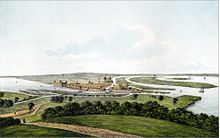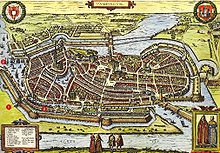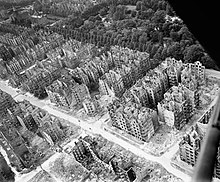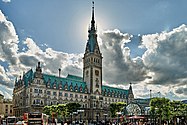
A | B | C | D | E | F | G | H | CH | I | J | K | L | M | N | O | P | Q | R | S | T | U | V | W | X | Y | Z | 0 | 1 | 2 | 3 | 4 | 5 | 6 | 7 | 8 | 9
Hamburg
Hamborg (Low German) | |
|---|---|
Municipality and state | |
| Free and Hanseatic City of Hamburg | |
| Coordinates: 53°33′N 10°00′E / 53.550°N 10.000°E | |
| Country | Germany |
| Government | |
| • Body | Hamburg Parliament |
| • First Mayor | Peter Tschentscher (SPD) |
| • Second Mayor | Katharina Fegebank |
| • Governing parties | SPD / Greens |
| • Bundesrat votes | 3 (of 69) |
| • Bundestag seats | 16 (of 736) |
| Area | |
| • City | 755.22 km2 (291.59 sq mi) |
| Population (2022-12-31)[2] | |
| • City | 1,945,532 |
| • Density | 2,600/km2 (6,700/sq mi) |
| • Urban | 2,484,800[1] |
| • Metro | 5,425,628 |
| Demonym(s) | German: Hamburger (male), Hamburgerin (female) English: Hamburger(s),[3] [4] Hamburgian(s) |
| GDP | |
| • Total | €144.220 billion (2022) |
| • Per capita | €76,910 (2022) |
| Time zone | UTC+1 (Central (CET)) |
| • Summer (DST) | UTC+2 (Central (CEST)) |
| Postal code(s) | 20001–21149, 22001–22769 |
| Area code(s) | 040 |
| ISO 3166 code | DE-HH |
| Vehicle registration |
|
| NUTS Region | DE6 |
| HDI (2021) | 0.972[6] very high · 1st of 16 |
| Website | hamburg.com |
Hamburg (German: [ˈhambʊʁk] ⓘ,[7] locally also [ˈhambʊɪ̯ç] ⓘ; Low Saxon: Hamborg [ˈhambɔːç] ⓘ), officially the Free and Hanseatic City of Hamburg,[8][9] is the second-largest city in Germany, after Berlin, and 8th-largest in the European Union, with a population of over 1.9 million.[10][1] The Hamburg Metropolitan Region has a population of over 5.1 million and is the ninth-biggest metropolitan region by GDP in the European Union.
At the southern tip of the Jutland Peninsula, Hamburg stands on the branching River Elbe at the head of a 110 km (68 mi) estuary to the North Sea, on the mouth of the Alster and Bille. Hamburg is one of Germany's three city-states alongside Berlin and Bremen, and is surrounded by Schleswig-Holstein to the north and Lower Saxony to the south. The Port of Hamburg is Germany's largest and Europe's third-largest, after Rotterdam and Antwerp. The local dialect is a variant of Low Saxon.
The official name reflects Hamburg's history as a member of the medieval Hanseatic League and a free imperial city of the Holy Roman Empire. Before the 1871 unification of Germany, it was a fully sovereign city state, and before 1919 formed a civic republic headed constitutionally by a class of hereditary Grand Burghers or Hanseaten. Beset by disasters such as the Great Fire of Hamburg, North Sea flood of 1962 and military conflicts including World War II bombing raids, the city has managed to recover and emerge wealthier after each catastrophe.
Major regional broadcaster NDR, the printing and publishing firm Gruner + Jahr and the newspapers Der Spiegel and Die Zeit are based in the city. Hamburg is the seat of Germany's oldest stock exchange and the world's oldest merchant bank, Berenberg Bank. Media, commercial, logistical, and industrial firms with significant locations in the city include multinationals Airbus, Blohm + Voss, Aurubis, Beiersdorf, Lufthansa and Unilever. Hamburg is also a major European science, research, and education hub, with several universities and institutions, including the Deutsches Elektronen-Synchrotron Laboratory DESY. The city enjoys a very high quality of living, being ranked 19th in the 2019 Mercer Quality of Living Survey.[11]
Hamburg hosts specialists in world economics and international law, including consular and diplomatic missions as the International Tribunal for the Law of the Sea, the EU-LAC Foundation, and the UNESCO Institute for Lifelong Learning, multipartite international political conferences and summits such as Europe and China and the G20. Former German chancellors Helmut Schmidt and Angela Merkel were both born in Hamburg. The former Mayor of Hamburg, Olaf Scholz, has been the current German chancellor since December 2021.
Hamburg is a major international and domestic tourist destination. The Speicherstadt and Kontorhausviertel were declared World Heritage Sites by UNESCO in 2015.[12] Hamburg's rivers and canals are crossed by around 2,500 bridges, making it the city with the highest number of bridges in Europe,[13] and with 5 of the world's 29 tallest churches standing in Hamburg, it is also the city with the highest number of churches surpassing 100 metres (330 ft) worldwide. Aside from its rich architectural heritage, the city is also home to notable cultural venues such as the Elbphilharmonie and Laeiszhalle concert halls. It gave birth to movements like Hamburger Schule and paved the way for bands including the Beatles. Hamburg is also known for several theatres and a variety of musical shows. St. Pauli's Reeperbahn is among the best-known European entertainment districts.
History
Origins
Claudius Ptolemy (2nd century AD) reported the first name for the vicinity as Treva.[14]
Etymology
The name Hamburg comes from the first permanent building on the site, a castle which the Emperor Charlemagne ordered constructed in AD 808. It rose on rocky terrain in a marsh between the River Alster and the River Elbe as a defence against Slavic incursion, and acquired the name Hammaburg, burg meaning castle or fort. The origin of the Hamma term remains uncertain,[15] but its location is estimated to be at the site of today's Domplatz.[16][17]
Medieval Hamburg

In 834, Hamburg was designated as the seat of a bishopric. The first bishop, Ansgar, became known as the Apostle of the North. Two years later, Hamburg was united with Bremen as the Bishopric of Hamburg-Bremen.[18]
Hamburg was destroyed and occupied several times. In 845, 600 Viking ships sailed up the River Elbe and destroyed Hamburg, at that time a town of around 500 inhabitants.[18] In 1030, King Mieszko II Lambert of Poland burned down the city. Valdemar II of Denmark raided and occupied Hamburg in 1201 and in 1214. The Black Death killed at least 60% of the population in 1350.[19] Hamburg experienced several great fires in the medieval period.[20]
In 1189, by imperial charter, Frederick I "Barbarossa" granted Hamburg the status of a Free Imperial City and tax-free access (or free-trade zone) up the Lower Elbe into the North Sea. In 1265, an allegedly forged letter was presented to or by the Rath of Hamburg.[21] This charter, along with Hamburg's proximity to the main trade routes of the North Sea and Baltic Sea, quickly made it a major port in Northern Europe. Its trade alliance with Lübeck in 1241 marks the origin and core of the powerful Hanseatic League of trading cities. On 8 November 1266, a contract between Henry III and Hamburg's traders allowed them to establish a hanse in London. This was the first time in history that the word hanse was used for the trading guild of the Hanseatic League.[22] In 1270, the solicitor of the senate of Hamburg, Jordan von Boitzenburg, wrote the first description of civil, criminal and procedural law for a city in Germany in the German language, the Ordeelbook (Ordeel: sentence).[23] On 10 August 1410, civil unrest forced a compromise (German: Rezeß, literally meaning: withdrawal). This is considered the first constitution of Hamburg.[24]
In 1356, the Matthiae-Mahl feast dinner for Hanseatic League cities was celebrated for the first time on 25 February, the first day of spring in medieval times. It continues today as the world's oldest ceremonial meal.[25]
Early modern period

In 1529, the city embraced Lutheranism, and it received Reformed refugees from the Netherlands and France.
When Jan van Valckenborgh introduced a second layer to the fortifications to protect against the Thirty Years' War in the seventeenth century, he extended Hamburg and created a "New Town" (Neustadt) whose street names still date from the grid system of roads he introduced.[26]
Upon the dissolution of the Holy Roman Empire in 1806, the Free Imperial City of Hamburg was not incorporated into a larger administrative area while retaining special privileges (mediatised), but became a sovereign state with the official title of the Free and Hanseatic City of Hamburg. Hamburg was briefly annexed by Napoleon I to the First French Empire (1804–1814/1815). Russian forces under General Bennigsen finally freed the city in 1814. Hamburg re-assumed its pre-1811 status as a city-state in 1814. The Vienna Congress of 1815 confirmed Hamburg's independence and it became one of 39 sovereign states of the German Confederation (1815–1866).
In 1842, about a quarter of the inner city was destroyed in the "Great Fire". The fire started on the night of 4 May and was not extinguished until 8 May. It destroyed three churches, the town hall, and many other buildings, killing 51 people and leaving an estimated 20,000 homeless. Reconstruction took more than 40 years.

After periodic political unrest, particularly in 1848, Hamburg adopted in 1860 a semidemocratic constitution that provided for the election of the Senate, the governing body of the city-state, by adult taxpaying males. Other innovations included the separation of powers, the separation of Church and State, freedom of the press, of assembly and association. Hamburg became a member of the North German Confederation (1866–1871) and of the German Empire (1871–1918), and maintained its self-ruling status during the Weimar Republic (1919–1933). Hamburg acceded to the German Customs Union or Zollverein in 1888, the last (along with Bremen) of the German states to join. The city experienced its fastest growth during the second half of the 19th century when its population more than quadrupled to 800,000 as the growth of the city's Atlantic trade helped make it Europe's second-largest port.[27] The Hamburg-America Line, with Albert Ballin as its director, became the world's largest transatlantic shipping company around the start of the 20th century. Shipping companies sailing to South America, Africa, India and East Asia were based in the city. Hamburg was the departure port for many Germans and Eastern Europeans to emigrate to the United States in the late 19th and early 20th centuries. Trading communities from all over the world established themselves there.
A major outbreak of cholera in 1892 was badly handled by the city government, which retained an unusual degree of independence for a German city. About 8,600 died in the largest German epidemic of the late 19th century, and the last major cholera epidemic in a major city of the Western world.
Second World War

Hamburg was a Gau within the administrative division of Nazi Germany from 1934 until 1945. During the Second World War, the Allied bombing of Hamburg devastated much of the city and the harbour. On 23 July 1943, the Royal Air Force and United States Army Air Force firebombing created a firestorm which spread from the Hauptbahnhof (main railway station) and quickly moved south-east, completely destroying entire boroughs such as Hammerbrook, Billbrook and Hamm South. Thousands of people perished in these densely populated working class boroughs. The raids, codenamed Operation Gomorrah by the RAF, killed at least 42,600 civilians; the precise number is not known. About one million civilians were evacuated in the aftermath of the raids. While some of the boroughs destroyed were rebuilt as residential districts after the war, others such as Hammerbrook were entirely developed into office, retail and limited residential or industrial districts.
The Hamburg Commonwealth War Graves Commission Cemetery is in the greater Ohlsdorf Cemetery in the north of Hamburg.
At least 42,900 people are thought to have perished[29] in the Neuengamme concentration camp (about 25 km (16 mi) outside the city in the marshlands), mostly from epidemics and in the destruction of Kriegsmarine vessels housing evacuees at the end of the war.
Systematic deportations of Jewish Germans and Gentile Germans of Jewish descent started on 18 October 1941. These were all directed to ghettos in Nazi-occupied Europe or to concentration camps. Most deported persons perished in the Holocaust. By the end of 1942, the Jüdischer Religionsverband in Hamburg was dissolved as an independent legal entity and its remaining assets and staff were assumed by the Reich Association of Jews in Germany (District Northwest). On 10 June 1943, the Reich Security Main Office dissolved the association by a decree.[30] The few remaining employees not somewhat protected by a mixed marriage were deported from Hamburg on 23 June to Theresienstadt, where most of them perished.
Post-war history

The city was surrendered to British Forces on 3 May 1945, in the Battle of Hamburg,[31] three days after Adolf Hitler's death. After the Second World War, Hamburg formed part of the British Zone of Occupation; it became a state of West Germany in 1949.
On 16 February 1962, a North Sea flood caused the Elbe to rise to an all-time high, inundating one-fifth of Hamburg and killing more than 300 people.
The inner German border – only 50 kilometres (30 mi) east of Hamburg – separated the city from most of its hinterland and reduced Hamburg's global trade. Since German reunification in 1990, and the accession of several Central European and Baltic countries into the European Union in 2004, the Port of Hamburg has restarted ambitions for regaining its position as the region's largest deep-sea port for container shipping and its major commercial and trading centre.
Geography
Hamburg is at a sheltered natural harbour on the southern fanning-out of the Jutland Peninsula, between Continental Europe to the south and Scandinavia to the north, with the North Sea to the west and the Baltic Sea to the northeast. It is on the River Elbe at its confluence with the Alster and Bille. The city centre is around the Binnenalster ("Inner Alster") and Außenalster ("Outer Alster"), both formed by damming the River Alster to create lakes. The islands of Neuwerk, Scharhörn, and Nigehörn, 100 kilometres (60 mi) away in the Hamburg Wadden Sea National Park, are also part of the city of Hamburg.[32]
The neighbourhoods of Neuenfelde, Cranz, Francop and Finkenwerder are part of the Altes Land (old land) region, the largest contiguous fruit-producing region in Central Europe. Neugraben-Fischbek has Hamburg's highest elevation, the Hasselbrack at 116.2 metres (381 ft) AMSL.[33] Hamburg borders the states of Schleswig-Holstein and Lower Saxony.
Climate
Hamburg has an oceanic climate (Köppen: Cfb), influenced by its proximity to the coast and maritime influences that originate over the Atlantic Ocean. The location in the north of Germany provides extremes greater than typical marine climates, but definitely in the category due to the prevailing westerlies.[34] Nearby wetlands enjoy a maritime temperate climate. The amount of snowfall has varied greatly in recent decades. In the late 1970s and early 1980s, heavy snowfall sometimes occurred,[35] the winters of recent years have been less cold, with snowfall just a few days per year.[36][37]
The warmest months are June, July, and August, with high temperatures of 20.1 to 22.5 °C (68.2 to 72.5 °F). The coldest are December, January, and February, with low temperatures of −0.3 to 1.0 °C (31.5 to 33.8 °F).[38]
| Climate data for Hamburg-Fuhlsbuttel (Hamburg Airport), elevation: 15 m, 1991–2020 normals) | |||||||||||||
|---|---|---|---|---|---|---|---|---|---|---|---|---|---|
| Month | Jan | Feb | Mar | Apr | May | Jun | Jul | Aug | Sep | Oct | Nov | Dec | Year |
| Record high °C (°F) | 14.4 (57.9) |
17.2 (63.0) |
23.0 (73.4) |
29.7 (85.5) |
33.5 (92.3) |
34.6 (94.3) |
40.1 (104.2) |
37.3 (99.1) |
32.3 (90.1) |
26.1 (79.0) |
20.2 (68.4) |
15.7 (60.3) |
40.1 (104.2) |
| Mean daily maximum °C (°F) | 4.2 (39.6) |
5.2 (41.4) |
8.7 (47.7) |
13.9 (57.0) |
18.0 (64.4) |
20.9 (69.6) |
23.2 (73.8) |
23.0 (73.4) |
18.8 (65.8) |
13.6 (56.5) |
8.2 (46.8) |
5.0 (41.0) |
13.6 (56.5) |
| Daily mean °C (°F) | 2.1 (35.8) |
2.4 (36.3) |
4.9 (40.8) |
9.1 (48.4) |
13.0 (55.4) |
16.0 (60.8) |
18.3 (64.9) |
18.0 (64.4) |
14.4 (57.9) |
10.0 (50.0) |
5.7 (42.3) |
2.9 (37.2) |
9.7 (49.5) |
| Mean daily minimum °C (°F) | −0.5 (31.1) |
−0.5 (31.1) |
1.1 (34.0) |
4.0 (39.2) |
7.6 (45.7) |
10.8 (51.4) |
13.3 (55.9) |
13.1 (55.6) |
10.1 (50.2) |
6.3 (43.3) |
2.9 (37.2) |
0.4 (32.7) |
5.7 (42.3) |
| Record low °C (°F) | −22.8 (−9.0) |
−29.1 (−20.4) |
−15.3 (4.5) |
−7.1 (19.2) |
−5.0 (23.0) |
0.6 (33.1) |
3.4 (38.1) |
1.8 (35.2) |
−1.2 (29.8) |
−7.1 (19.2) |
−15.4 (4.3) |
−18.5 (−1.3) |
−29.1 (−20.4) |
| Average precipitation mm (inches) | 66.7 (2.63) |
54.9 (2.16) |
56.7 (2.23) |
39.2 (1.54) |
57.8 (2.28) |
74.4 (2.93) |
81.8 (3.22) |
77.5 (3.05) |
64.7 (2.55) |
63.0 (2.48) |
61.1 (2.41) |
72.6 (2.86) |
770.5 (30.33) |
| Average precipitation days (≥ 1.0 mm) | 17.7 | 16.2 | 15.2 | 12.8 | 13.8 | 15.3 | 16.0 | 15.8 | 14.5 | 16.2 | 16.9 | 18.0 | 188.4 |
| Average snowy days (≥ 1.0 cm) | 5.9 | 5.0 | 2.9 | 0 | 0 | 0 | 0 | 0 | 0 | 0 | 1.2 | 3.5 | 18.5 |
| Average relative humidity (%) | 85.8 | 82.6 | 77.7 | 71.0
Zdroj:https://en.wikipedia.org?pojem=Free_and_Hanseatic_City_of_Hamburg Text je dostupný za podmienok Creative Commons Attribution/Share-Alike License 3.0 Unported; prípadne za ďalších podmienok. Podrobnejšie informácie nájdete na stránke Podmienky použitia.
Analytika
Antropológia Aplikované vedy Bibliometria Dejiny vedy Encyklopédie Filozofia vedy Forenzné vedy Humanitné vedy Knižničná veda Kryogenika Kryptológia Kulturológia Literárna veda Medzidisciplinárne oblasti Metódy kvantitatívnej analýzy Metavedy Metodika Text je dostupný za podmienok Creative
Commons Attribution/Share-Alike License 3.0 Unported; prípadne za ďalších
podmienok. www.astronomia.sk | www.biologia.sk | www.botanika.sk | www.dejiny.sk | www.economy.sk | www.elektrotechnika.sk | www.estetika.sk | www.farmakologia.sk | www.filozofia.sk | Fyzika | www.futurologia.sk | www.genetika.sk | www.chemia.sk | www.lingvistika.sk | www.politologia.sk | www.psychologia.sk | www.sexuologia.sk | www.sociologia.sk | www.veda.sk I www.zoologia.sk | |||||||||











